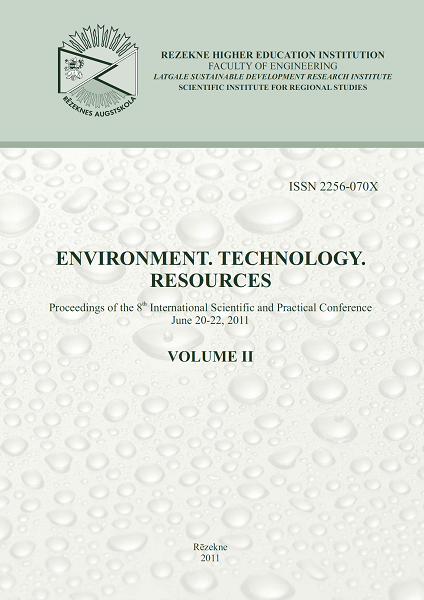The Diversity Of Weeds In Organic Linseed And Flax Crop
DOI:
https://doi.org/10.17770/etr2011vol2.974Keywords:
Linum usitatissimum L., flax, linseed, organic farming, conventional farming, weedsAbstract
The flax is grown in the world for many years. The area of linseed in the world is much more than that of fibre flax. The seeds of ecologically grown linseed have high value as the row material for food, medicine, fodder, oil production. The cold pressed oil and seeds of ecologically grown linseed are especially popular in EU, Canada and USA. The quality of the finished linen product is often dependent upon growing conditions and harvesting techniques. The organic textile trend is starting to develop worldwide, while in Lithuania it is still almost non-existent. Therefore, the chance for Lithuanian farmers appears to export the ecological seed and fiber, not only use them in local market. Lithuanian farmers are in luck for the advices how to grow flax in ecological way. Therefore, in 2007- 2009 some investigations were carried out at the Upytė Experimental Station of the Lithuanian Research Centre for Agriculture and Forestry (Panevėžys district, Lithuania). The results of our investigation showed that it is possible to grow and harvest fibre flax and linseed in organic farms without any pesticides. The incidence of weeds is one of the biggest problems in organic growing of flax and linseed.Downloads
References
International Federation of Organic Agriculture Movements (2011). www.ifoam.org.
Jankauskienė, Z. Common flax weeds and their control in Lithuania // Development of environmentally friendly plant protection in the Baltic region. Proceedings of the International Conference, Tartu, Estonia, September 28-29, 2000. Tartu, 2000, p.54-56.
Nalewaja, J.D., Miller, S.D., Dexter, A.G. Postemergence herbicide combinations for grass and broadleaf weed control. Proceedings of the North Central Weed Control Conference, North Dakota, USA, 1980, Vol.35 p.43-44.
Mikaliūnienė, V. Įvairaus veikimo herbicidų mišinių efektyvumas linuose ir poveikis kukurūzams. Zemdirbyste-Agriculture. 1996, Vol.54, No.3, p.117-127 (in Lithuanian).
Mikaliūnienė, V., Mikelionis, S. Herbicidai aliejiniams linams. Integruota augalų apsauga : pasiekimai ir problemos. Dotnuva-Akademija, 1997, p.215-218 (in Lithuanian).
Heller K., Weed management in fibre flax for sustainable agriculture in Poland. Materials of the Scientific Conference, devoted to the 35-th Anniversary of the Institute of Plant Protection. Minsk, 2006, Vol.30, No.1, p.166-169 (in Russian).
Prudnikov, V.A., Shipko, P.I. Effectiveness of minimal doses of herbicides on flax crop. Materials of the Scientific Conference, devoted to the 35-th Anniversary of the Institute of Plant Protection. Minsk, 2006, Vol.30, No.1, p.140-144 (in Russian).
Heller K., Adamczewski K., Nanaszko J.M. Susceptibility of fiber flax cultivars to herbicides. Journal of Plant Protection Research. 2002, Vol.42 No.2, p.113-130.
Gautam, S., Singh, C.M. Studies on residue estimation of different herbicides by bioassay techniques using different oilseed plants as indicator plants. Indian Journal of Weed Science 1991, Vol.22, No.1-2 p.47-52.
Nanaszko, M. Adamczewski, K. Heller, K. Herbicides influence on cultivars' fibre yield and its quality. Progress in Plant Protection. 2000, Vol.40 No.1 p.408-417.
Dufour, R. Farmscaping to enhance biological control. National Sustainable Agriculture Information Service 2000. http://attra.ncat.org/attra-pub/farmscape.html.
Auškalnis, A., Auškalnienė, O. Weed control in spring barley by harrowing. Zemdirbyste-Agriculture. 2008, Vol.95, No.3, p.388-394.
Duval, J. Mechanical weeds control in cereals. 1997 Ecological Agriculture Projects. http://eap.mcgill.ca/publications/EAP72.htm#OILSEED CROPS.
Mikaliūnienė, V. Kai kurių herbicidų bei jų derinių palyginimas linų pasėliuose. Herbicidai: LŽMTI darbai. Vol.36. Vilnius, 1988, p.159-168 (in Lithuanian).
Berglund, D.R. Zollinger, R.K. Flax Production in North Dakota. 2007. http://www.ag.ndsu.edu/pubs/ plantsci/crops/a1038w.htm.
Tishkov, N.M., Dryachlov, А.А. Competitiveness of flax in relation to weeds depending on crop and weed species in their composition. Oilseeds. 2005, No.1, p.115-120 (in Russian).
Mikelionis S., Endriukaitis A. Sėmeninių linų agrotechnika. Žemdirbystė-Agriculture. 2000, Vol.69, p.96-107 (in Lithuanian).
Liebman, M., Dyck, E. Crop Rotation and Intercropping Strategies for Weed Management. Ecological Applications 1993, Vol.3, No.1, p. 92-122.
Bond, W., Grundy, A.C. Non-chemical weed management in organic farming systems. Weed Research. 2001, Vol.41, Iss.5, p. 383–405.
Maikštėnienė, S., Arlauskienė, A., Velykis, A., Satkus, A. Enhancement of competitive ability of cereals towards weeds by means of crop rotations. Zemdirbyste-Agriculture. 2009, Vol.96, No.2 p.23–34.
Heller K. „Flax specialists”-weed species extinct in Poland? Journal Plant Breeding and Seed Science. 2010, Vol.61, p.35-40.


